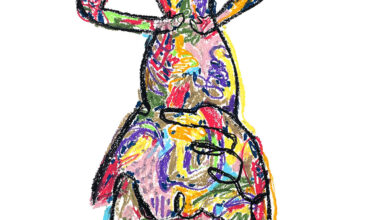In Retrospect: Fatima Lopes
Looking back on Fátima Lopes’ 30-year career celebration with her Autumn/Winter 2022/23 Collection

Coverage by Guido Avelino
A new day, a new backstage coverage for Fernanda and me to unravel. This time, we’re looking back on Fátima Lopes’ 30-year career, with her Autumn/Winter 2022/23 Collection. The exquisite event took place at the Exhibition Pavilion of the School of Agriculture, here in Lisbon. The Pavilion, known for its victorian iron structure and killer overview of the April 25th Bridge, was now set with seats all over, with endless nameplates on top of it. Plates that indicated where 2000 of Fátima’s invitees should be seated—all of whom were invited to celebrate the three-decade mark of her eventful career.
Not a stranger to a big splash, Fátima put on a fashion show with 86 models, to tell in retrospect the epic narrative of all things Fátima Lopes: from the 1990s to the happening—all with a contemporary twist. On the trip down memory lane, we revisited some of the most memorable moments of Fátima’s career. By taking a closer look at the right gems, you could discern all the self-referential elements, intertwining Fátima’s past and present.

Fátima undoubtedly knows what she’s doing. This celebration is not the first—and hopefully not the last—she has put together. From the genesis of her brand, her meticulous involvement in all production aspects has been the hallmark of the creative process behind her shows, and that is one of the reasons behind such prestige on the mark over the past three decades.
The atmosphere backstage was filled with ebullient tension. All of the models were represented by Face Models, Fátima’s modelling agency. And truly: apart from the 2000 invited guests, it all felt like a big family gathering. Joy overcame any apparent nerves that might have surfaced in the place: the mood was celebratory.
The multitude of models was being taken care of by the hands of Antónia Rosa, Head of Makeup and ZOOT Beauty Editor, alongside Maria Lourenço, Head of Hairstyle, and her team. Both teams working side-by-side to deliver the very best depiction of three distinct looks: Young, Glamour and Sophisticated, showcasing respectively the three decades of Fatima’s work.
Greetings from the ‘90s
Born on Madeira Island, Fátima moved to Lisbon at the age of 25. From opening a concept store in downtown Lisbon on the (in)famous Rua Rosa to launching her namesake clothing brand, the first segment of the show pays homage to the beginnings of her story.
Capturing, in essence, the best of what was en vogue around the ‘90s, the show opened with model Margarida Zhang playing the role of young Fátima, rocking a hime haircut, just like Fátima used to back in the day. Golden ornate beads and tailored high-waisted pants completed the first look, while Margarida strutted down the catwalk and invited the audience to the preface of Fatima’s fantasy.
Gilded micro-skirts, sheer tops and dark-toned denim followed down the runway, all with one big trait in common: a lot of shimmer, no matter the piece—in true 90s spirit.


The Turn of the Aughts
Before marking the turn of the millennium—and turning up in the iconic diamond bra—in the late ‘90s, Fátima was already a household name in the fashion scene and becoming one of the first Portuguese designers to ever show at Paris Fashion Week.
Following the sexy heist of the fashion scene in the early 2000s, she represented the era in its truest, scantily-clad form: plenty of skin, a bunch of glow and a lot of sex appeal. Off-white dresses and asymmetrical tailored blazers for both men and women ease up formalities without compromising class.


The Vivid ’10s
Much for the men in the 1910s, as for us in the 2010s, the menswear collections kept with the formal flair and sober tones. There was a cohesive language in the way the models were styled with splashes to pique interest, distinguishing one garment from the other: a pop of bright red, encrusted collars or see-through fabric all ended up working in juxtaposition with some of the latter garments worn by the ladies.

Ah, how I can readily recall the four scene-stealers that ultimately made the show…and, really, there was probably not a single person in attendance who would disagree with me. The first was a variation of black bedazzled gowns with big side slits revealing just enough leg. Collarbones emphasized, à la revenge dress, caught everybody’s attention, as the models Eliana Ring, Maren Zils and Charlotte walked charmingly on the 140-meter catwalk.
Right after, a power combo of see-through emerald cocktail dresses paired with thigh-high boots, worn by Marija Silov and Sandra Ramos Fernandes, followed through. It was the visual depiction of Barbarella, if only she was a nepo baby born in a golden cradle in the year 2000.


There were also all the departures that came from the jewel-toned checkered black and green gowns, all worn by Mariana Fernandes, Carolina Baltasar and Rainara. The gowns featured a subtle ’70s flair to them, eliciting excitement yet again, model after model.
And lastly, the coup de grâce to tie it all in: two scarlet red killer dresses worn by none other than Anneli Lauren and the muse of the show herself, mother and actress Marisa Cruz, Fátima’s longtime friend and partner in crime.

As the show ended and Fátima walked down the runway with all the models, I found myself alone backstage and got to experience my favorite part of the entire evening: while sitting at a table, I got to see as they all came back. I was no longer alone and all of a sudden the room was no longer empty, but filled up with much joy. At this moment I realized just how much more than just her artwork she was putting out to everyone there, and it showed.
Congratulations, Fátima, on the three extraordinary decades of sharing your creative vision with the world.






